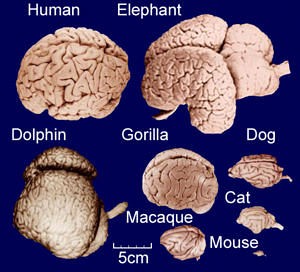The first study by a group of neuroscientists to examine the number of neurons in the brains of animals
In an article “Sorry, Grumpy Cat: Study finds dogs are brainier than cats”, published by Science Daily http://bit.ly/2j41cCK , and sourced from Vanderbilt University, researchers found that dogs possess significantly more cortical neurons than cats.
The number of neurons in the cerebral cortex, or the “little grey cells”, is ordinarily associated with complex thinking and behavior, which are considered to be the hallmarks of intelligence and cognitive capabilities.
This is the first study that actually included counting the number of cortical neurons in a number of carnivores, including cats and dogs. (Carnivora is a diverse order that consists of 280 species of mammals all of which have teeth and claws that allow them to eat other animals.) The researchers analyzed the brains of eight carnivoran species: ferret, mongoose, raccoon, cat, dog, hyena, lion and brown bear.
The method for accurately measuring the number of neurons in brains was developed by Suzana Herculano-Houzel http://www.suzanaherculanohouzel.com/lab , formerly at the Federal University of Rio de Janeiro, Brazil, now an Associate Professor of Psychology and Biological Sciences at Vanderbilt University. “In this study, we were interested in comparing different species of carnivorans to see how the numbers of neurons in their brains relate to the size of their brains, including a few favorite species such as cats and dogs, lions and brown bears,” said Professor Herculano-Houzel.
The study by Herculano-Houzel group published in Frontiers in Neuroanatomy http://bit.ly/2j33kLb found that dogs possess about 530 million cortical neurons while cats have only about 250 million, in comparison to the human brain that has 16 billion. Based on this analysis, it is expected that dogs have better cognitive capabilities than cats.
neurons while cats have only about 250 million, in comparison to the human brain that has 16 billion. Based on this analysis, it is expected that dogs have better cognitive capabilities than cats.
“I believe the absolute number of neurons an animal has, especially in the cerebral cortex, determines the richness of their internal mental state and their ability to predict what is about to happen in their environment based on past experience,” Herculano-Houzel explained.
In studying the number of neurons, scientists also analyzed the ratio of neurons to brain size and observed that in the largest carnivorans the neuron-to-brain-size ratio is actually lower. For example, the golden retriever has more neurons than a hyena, lion or brown bear, even though the bigger animals have much larger brains. The most extreme example is the bear whose brain is 10 times larger than a cat’s but has about the same number of neurons.
By studying the brains of different species, neuroscientists can learn if there are any patterns in how nature has put brains together and shed a greater light on the enormous diversity that exists among them.
Video: https://www.youtube.com/watch?v=8Ah5G9iYLO0
By NextStepU Editorial Team
___________________________________________________________________________
Story Source:
Materials provided by Vanderbilt University. Originally written by David Salisbury.
Journal Reference:
- Débora J. Alvarenga, Kelly Lambert, Stephen C. Noctor, Fernanda Pestana, Mads F. Bertelsen, Paul Manger and Suzana Herculano-Houzel. Dogs have the most neurons, though not the largest brain: Trade-off between body mass and the number of neurons in the cerebral cortex of large carnivoran species. Neuroanat., 2017 DOI: 10.3389/fnana.2017.00118

